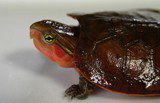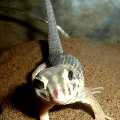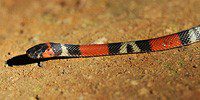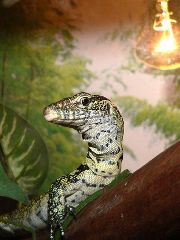
Nile monitor
The Nile monitor lizard (Varanus niloticus) is another one of the huge number of representatives of lizards.
In length, these animals can reach up to 2 meters, although such individuals are very rare. As a rule, the body size of a monitor lizard is 1.7 meters, of which 1 meter falls on the tail. In reptiles of this species, the tail is laterally flattened and equipped with a longitudinal keel (crest) on top. On the head there are no longitudinal rows of wide scales above the eyes, the nostrils are round and set closer to the anterior margin of the eye. The teeth of monitor lizards are cone-shaped in front, and with blunt crowns in the back.
The body color of the lizards is a dark yellowish-green gamut, against which there is a beautiful pattern of irregular transverse stripes formed by small yellow specks and spots. Between the shoulders and groin are horseshoe-shaped yellow spots, and in front of the shoulders is a black semicircular stripe. The color of the tail in its lower part is yellow with transverse stripes, and the first aunt of the tail has yellow-green rings.
Distribution
The Nile monitor is in all the rivers penetrating the African continent, with the exception of those that flow in the northwestern part of this continent. Representatives of this species were found not only in Egypt and Nubia, but also in Upper and Lower Guinea and East Africa. Single lizards of this species can be found in Eastern Sudan, where they are found alone.
Life in nature
In nature, the Nile monitor lizards, like their relatives, the striped monitor lizards, have a strong connection with water and never move far from rivers and lakes, on the banks of which they lead their lives.
This kind of described animal spends most of its time in the water, where it hides all the time, and when it comes out on land, it usually lies motionless and basks in the sun. The main place of his rest on earth is the horizontal peaks, steeply descending to the water coast, but the most favorite place is the top of the coastal cliff. Monitor lizard can sometimes be found in the coastal bush, but he does not linger there, but hurries back to the water.
They are sheltered by water-washed tree roots in the coastal shrub zone in rivers that dry up in summer.
Scientists are still arguing whether these animals are subject to summer hibernation or not, since they are still not as dependent on water as crocodiles.
When danger arises, the monitor lizard, if possible, flees, but if this is not possible for a number of reasons, then it pretends to be dead and lies like that for quite a long time, waiting until it is possible to jump to its feet and hide.
These lizards are predators. They feed on small mammals, birds, reptiles, which are in great abundance in Egypt, and especially near the rivers. Monitor lizards also rob and destroy the nests of coastal birds, often visit pigeon houses and poultry houses, attack soft-skinned turtles and insects. Often, Nile monitor lizards dig up the nests of crocodiles and turtles, swallowing their eggs whole. Very hard food, such as crab shells and bivalve shells of mollusks, the lizard crushes with its thickened and blunted back teeth.
Content in captivity
 Nile monitors are very tenacious reptiles, which makes them quite suitable for keeping in captivity. It is quite interesting and attractively colored and is an interesting animal to observe. The lizard becomes a good pet only in the presence of a large and well-equipped terrarium.
Nile monitors are very tenacious reptiles, which makes them quite suitable for keeping in captivity. It is quite interesting and attractively colored and is an interesting animal to observe. The lizard becomes a good pet only in the presence of a large and well-equipped terrarium.
Animals caught in the wild must be quarantined and checked for helminths before being transferred to a permanent place of residence. These caught specimens are very aggressive, but with enough patience they can be tamed. This is best done with young lizards, since the older the animal, the worse it makes contact.
It is best to place Nile monitor lizards in horizontal terrariums, young animals need a volume of at least 75 liters, which should increase with the growth of the lizard so that it would be comfortable for her to live there and the ion does not lack space.
The best “soil” for the bottom of the terrarium is a plastic artificial turf with a pile height of about 2mm, it must be washed and dried periodically. You can also use pine sawdust, aspen chips, orchid bark as a substrate. The monitor lizard needs driftwood and stones on which to lie and bask, so having them in a terrarium is a must. It should also have a reservoir of sufficient volume so that the reptile can completely dive into it freely.
For these lizards, the temperature regime of their environment is also important. The daytime temperature in the terrarium should vary between 26-32°C in the cold and warm zones, respectively, and at night – 25-26°C. Animals require moderate humidity, it will be created by finding a reservoir, but if this is not enough for some reason, then the terrarium must be periodically sprayed.
An extremely important condition for keeping a monitor lizard is the presence of a Reptiglo ultraviolet lamp with an emission spectrum of 8.0 units.
Nile monitors are carnivores and therefore their home diet should consist of a variety of live organisms such as crickets, zoophobes, small rodents (mice, hamsters, small guinea pigs), non-oily fish, reptiles (frogs, small lizards), eggs. Do not forget about the need to regularly give animals vitamin and mineral preparations.
It is necessary to clean the terrarium regularly, change the water in the pool and clean up after feeding the monitor lizard parts of the animals that he did not eat or abandoned. This must be done to prevent rotting of organic elements and sagging of water.
Reproduction
Reproduction of monitor lizards occurs in January-February. This period falls on the rainy season. The female lays 40 to 60 large eggs in a termite mound. She easily destroys his stacks with her forelimbs. The development of offspring occurs within 9-10 months. After hatching, liquid is poured out of each egg, which is necessary in order to soften the walls of the termite mound and young lizards can get out of it. The size of the offspring does not exceed 22 cm in length. After they have left the eggs, monitor lizards are capable of independent life and nutrition.
Interesting facts
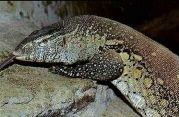 The ancient Egyptians considered the Nile monitors to be slayers of crocodiles, which were given divine honors.
The ancient Egyptians considered the Nile monitors to be slayers of crocodiles, which were given divine honors.
The meat and fat of the Nile monitor lizard are very tasty and therefore are widely used by the local inhabitants of Africa for food. In Zanzibar, these animals are caught, tied to a stick and sold to the local market.
For the sake of fun, the natives kept monitor lizards, small animals were launched into their cage, which were torn apart by a bloodthirsty lizard under general supervision.



